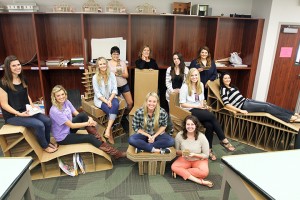
Travis Taylor | Lariat Photo Editor
Reporter
Interior Design Studio 1 students received one of the greatest challenges of their design careers – building fully functional chairs using nothing more than cardboard and glue.
Elise King, lecturer in the interior design department, said the students were given two and a half weeks to use re-purposed cardboard and Elmer’s glue to create aesthetically pleasing pieces of furniture. Students were urged to research the physical properties of cardboard to determine the most effective way to use the material, King said.
“I wanted them to focus on the material itself and to design something that is functional, but have the product be sustainable,” she said.
King said the chairs had to support at least 170 pounds of weight, although many were able to support more.
“I really wanted for the focus to be on creating something that is functional,” she said. “The chairs have worked really well so far.”
The project aimed to educate the design students about the process of developing truly green furniture. King said the design industry produces an abundance of products with an environmental friendly label that is “slapped on” for the sake of having a green status.
“‘Sustainable design’ is a buzz-word that the design community throws around sort of haphazardly,” King said.
In the fashion of Baylor sustainability, King said she wanted to give her students the opportunity to create authentically re-purposed furniture.
“A lot of the time with sustainable products, the goal is just to say that they’re sustainable,” she said. “I wanted for them to be able to, for themselves, construct something that actually is.”
Each group, which consisted of two students, was given a target environment for which to construct the chairs. The finished products featured chairs intended for dining, reclining, cross-legged sitting, office use and reading–built-in bookshelf included.
King said the students followed several developmental steps before beginning construction. Each group had to find design inspiration from sources such as architecture or pre-existing chair designs.
Afterward, several sketches of ideas for construction were completed by each group. Students also studied the physics of construction and built miniature scale models of the chairs, noting any structural or aesthetic problems with the designs. The construction process was consistently documented with photographs.
“The process was a large component,” King said. “I knew that they were going to do a good job, but they exceeded my expectations.”
During the second day of the project, the students visited Waco’s Homestead Heritage to learn about constructing without power tools, which they were not permitted to use during construction, King said.
Homestead Heritage specializes in handcrafted products.
A group that built a chair for tailor-style, or cross-legged, sitting took creative measures to ensure the chair fit the contour of crossed human legs, King said. The group studied chairs that fit the parameters of their design, took leg measurements from about 20 people and even applied paint to their legs and sat on a piece of foam to identify the major pressure points of tailor-style seating.
“They did a really great job as far as research goes,” King said.
Pleasanton, Calif., junior Meredith Mills, who worked on the tailor-style chair, said the project was initially intimidating. The students had doubts about their knowledge of physics and construction, as well as their abilities to work with such a limited choice of materials.
“We thought, ‘There’s no way,’” she said. “We’ve never had to think in that way before.”
Bradenton, Fla., senior Ariel Pecoraro, who was partnered with Mills, said she had the same concerns, but their design allowed them to solve a “real-world problem.” Pecoraro said consistent cross-legged sitting places pressure on the legs, causing foot bunions, which was a problem for tailors in earlier centuries.
“Tailors used to sit crisscross on the ground and they would do all of their sewing like that,” Pecoraro said. “In our research, we saw that the problem was that your legs bear into the ground heavily, so tailors would get bunions. It was cool to see that what we were finding as problems we were also finding solutions to.”
Remaining patient during the construction process proved to be difficult, Mills said.
“It was really hard when we were actually gluing pieces together to get it to stick, and it wasn’t going as fast as we wanted it to,” she said.
Pecoraro said finding common ground between form and function was one of the most challenging aspects of the project.
“After making our small model, we saw some things we needed to fix that weren’t so aesthetically pleasing,” she said. “It was hard to make sure the chair met all of our functional needs as well looked good.”
The chairs were displayed for the first time during Family Weekend in the Goebel Building, which houses the design studio.
“We got great feedback from a lot of people coming into the building,” she said.
King said the students excelled at planning, research and production.
“It was a big challenge to present to them, but they did an excellent job,” she said. “I’m extremely pleased.”
No decisions have been made regarding the future of the chairs, although art displays in Waco, on-campus displays and a fundraiser auction in support of the interior design department are all being discussed, King said.






